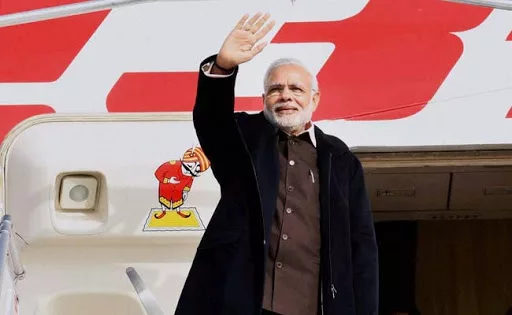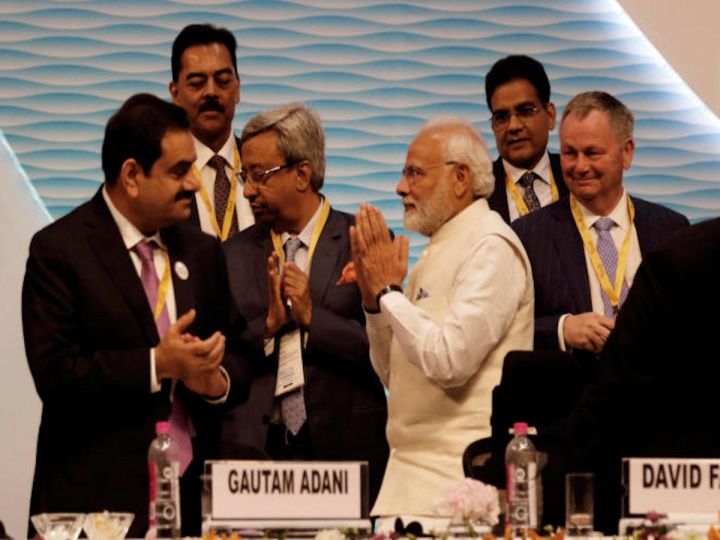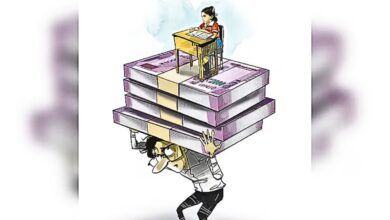Times When PM Narendra Modi Went On Foreign Trips And Adani Or Ambani Got Business Contracts
Since May 2014, when Narendra Modi became the Prime Minister Of India, the BJP-led ruling party has lauded the diplomatic winnings that came with each of his foreign visit, thus upping India's place in the global centre stage. However, while this is commendable, there is yet another pattern that has emerged over the last few years: and that is that with each foreign visit, certain business groups have emerged as "winners".

PM Narendra Modi has emerged as an influential leader, who has also been on a mission – Globetrotting – and with each diplomatic visit, he has been accompanied by robust and prominent businessmen.
One, in particular, has caught the eye of many since he is in the present himself in the centre of a storm that has been “brewing” and getting “stronger” with each passing day – Gautam Adani, Adani Group.
The last few days have been a frenzy not only for Gautam Adani but also for the PM, Narendra Modi. His carefully constructed image is now crumbling in a clear understanding that there has indeed been “favouritism” that may have been in play all these years.

Here are some facts to substantiate why it may be true –
As the PM of India, in the first four years, as per facts disclosed in replies to questions under the Right to Information Act with the Prime Minister’s Office – Narendra Modi travelled to 52 different countries on 41 occasions over an incremental period of 165 days.
And who were the two business tycoons that accompanied him on several of these foreign trips?
None other than Gautam Adani and Anil Ambani.
Whatsmore, Companies controlled by these two individuals signed nearly 18 agreements in 16 countries, and thirteen of these deals concerned corporate entities in the Adani group.
In contrast, five of these deals were done by companies under the Anil Dhirubhai Ambani Group (ADAG).
But this is what needs to be noted; only a hand full had heard of Gautam Adani two decades ago.

Today, the Adani group has many leading businesses. Adani outshined the list of billionaires in terms of percentage gain in net worth in a year –from $4.63 billion in January 2017 to a whopping $10.4 billion in December that year, an increase of 124.6%, which is by no means a small percentage.
The Rise of Modi Is the Rise of Adani And Ambani?
Although it cannot be said that Congress regimes had been unkind to Adani, however, his astonishing rise as a business tycoon has overlapped with Modi’s ascension to power, first as Modi the Chief Minister of Gujarat from 2001 for 12 years and then from May 2014 onwards as Prime Minister of India.
Why This Reeks Of Favouritism?
To further substantiate this point, here are some examples of the same – what are three major critical sectors for India – Defence, Logistics and Power.
While Defence is a mixed bag of Anil Ambani and Adani-led deals, Ambani got the majority of deals here, whereas when it comes to logistics and power deals, the majority of the same went to Adani’s kitty.
Take a Look
Logistics –
Modi visited Japan in 2014; Adani, Sunil Mittal and other industrialists were part of Modi’s delegation on his first significant bilateral visit to Japan in 2014.
Media reported that Adani Logistics Limited subsequently signed an agreement with the Japanese firm NYK Auto Logistics to form a joint venture specialising in the transportation of finished vehicles using automobile freight trains.
Australia – Beneficiary – Adani
Modi appeared at the G20 Summit in Brisbane in 2014; Adani was part of a delegation of businessmen accompanying Modi.
The Adani group won a promise from the Queensland government to take short-term, minority stakes in the railways and port infrastructure needed to unlock the massive coal reserves in the Galilee Basin.
Adani and State Bank of India Chairperson Arundhati Bhattacharya signed a memorandum of understanding (MoU) for a ₹6,200-crore loan for what was claimed to be the world’s “largest greenfield coal mining project”, which is currently embroiled in several controversies.
Malaysia – Beneficiary – Adani
Modi visited Malaysia in 2015; in 2017, the governments of India and Malaysia signed business deals; in the same year, the Adani group signed an MoU with Malaysia’s MMC Ports to conduct a feasibility study of the Carey Island Port Project, which would be an extension of Port Klang, currently the 11th busiest container port in the world.
Modi visited Iran in 2016, and a commercial contract relating to Chabahar port was signed between India Ports Global and Iran’s Aria Banader, the Indian government said it was committed to investing $500 million in the first phase of the project that would include a $150 million credit facility to Iran through the Export-Import Bank of India.
After India Ports Global floated a tender, Adani Ports and Special Economic Zone Limited, the J M Baxi Group and JSW Infrastructure Limited (part of the Jindal Steel Works group) were short-listed.
Mozambique – Beneficiary – Adani
Modi visited the country in 2016, and a long-term agreement was signed under which India would buy pulses from this country to reduce its shortfall in demand and contain prices.
Modi said the agreement would meet India’s requirements while helping raise farmers’ incomes in Mozambique.
Interestingly, Adani Ports signed an agreement with the India Pulses and Grains Association (IPGA) to import pulses and storage in Indian ports.

Ahead of Modi’s visit to Oman in February 2018, the Oman Company for the Development of Special Economic Zone at Al-Duqm (Tatweer) signed an MoU with Adani Ports and Special Economic Zone in September 2017. In February, Modi discussed measures to strengthen trade and investment in energy, defence and food security.
If we look at the defence sector, then between 2015 – 2017, Narendra Modi visited France, Sweden, Isreal, Russia, USA and incredibly, as the PM’s footsteps registered in these countries, so did mega deals that went to none other than the two business tycoons accompanying him in these visits.

Defence
Sweden – Beneficiary – Adani & Ambani
To elaborate this further, on his maiden trip to India, in 2013, Swedish Prime Minister Stefan Lofven arrived as the head of government with a Swedish delegation to participate in the “Make in India” week in Mumbai in 2016.
The following year Saab disclosed that it was tying up with the Adani group to bid for manufacturing single-engine fighter aircraft in India.
The deal for 100-plus fighter aircraft was estimated to be worth over ₹60,000 crores.
Meanwhile, For Anil Ambani too, there was a lucrative deal made here; his Reliance Defence and Aerospace in 2015, a year prior, tied up with defence giant Saab AB of Sweden to bid for the ship-borne unmanned aerial vehicle (UAV) programme of the Indian Navy valued at ₹1,000 crores.
France – Beneficiary – Ambani
Interestingly, there were news reports that Anil Ambani’s Reliance Defence was incorporated on March 28, 2015.
This was just 12 days before Modi, who visited France in 2015, announced in France that India would purchase 36 Rafale fighter planes in flyaway condition.
According to reports, India would be paying ₹58,000 crores for 36 Rafale fighter jets which works out to just over ₹1,600 crores per aircraft.
At that time, it was claimed that the Indian Air Force needed the planes urgently and that these 36 planes would reach India within two years.
But even four years later, the aircraft are nowhere in sight. It was stated in Parliament that the first Rafale fighter aircraft would come only by September 2019, well after four-and-half years after the Prime Minister’s announcement.
Isreal – Beneficiary – Adani & Ambani
In March 2016, the Adani group’s Aero Defence Systems & Technologies Ltd. signed a statement of intent with Elbit-ISTAR of Israel and the Indian company Alpha Design Technologies Private Limited to work together in manufacturing and to develop unmanned aircraft systems (UAS).
In the same month, Anil Ambani’s Reliance Defence announced a deal with Israel’s Rafael Advanced Defence Systems (not to be confused with the French Rafale aircraft) to develop air-to-air missiles for the IAF valued at about ₹65,000 crores.
Russia – Beneficary – Ambani
Modi visited Russia in 2015, and Reliance Defence signed a manufacturing and maintenance deal potentially worth $6 billion with Russia’s Almaz-Antey, the makers of air defence systems.
The partnership was announced as Modi began a Moscow trip to strengthen defence ties between India and Russia. However, on Russian president Vladimir Putin’s arrival in India, the same deal was inked at a comparatively lower price of $5.4 billion (₹39,000 crores).
USA – Beneficiary – Ambani
In 2017, Reliance Defence and Engineering signed an agreement with the US Navy for undertaking the service, maintenance and repair of the Seventh Fleet of the American Navy at the Reliance group’s shipyard at Pipavav in Gujarat. According to a report in the Mint, the deal is expected to generate revenue worth ₹15,000 crores for Reliance Defence over the next three to five years.

Power
Bangladesh – Beneficiary – Ambani and Adani
Reliance Power and Adani Power signed separate MoUs with the government-run Bangladesh Power Development Board (BPDB) to set up several power plants in Bangladesh, while Reliance Power signed an MoU to develop four power plants to produce 3,000 MW of electricity at the cost of $3 billion, Adani Power decided to set up two coal-fired plants with a total capacity of 1,600 MW costing more than $1.5 billion.
Similarly, there are other countries on the list, and the list would have substantially grown from then to the present.
The Disclosure
The Favourism game became known when media reports surfaced with a high-ranking Sri Lankan official deposing before a Parliamentary committee, alleging Modi’s pressure to award a renewable energy project in the Mannar province of the country to the Adani Group.
Right after the Sri Lankan episode and the Australian coal imports issue, which again involved the Adani group, went public, many started to see the pattern of Modi’s various overseas visits and instances of the Prime Minister’s alleged misuse of his office and position in calling favours to benefit the Adani Group and the Ambani Group as well.
Conclusion: It is apparent that there is a striking pattern in many of Modi’s foreign visits, and foreign governments striking deals with either the Adani Group or Ambani’s Reliance Group soon after the Prime Minister’s visit.
Therefore, is it possible to say that these are mere coincidences involving the two business people and the PM’s office and that there is nothing much to investigate here?




